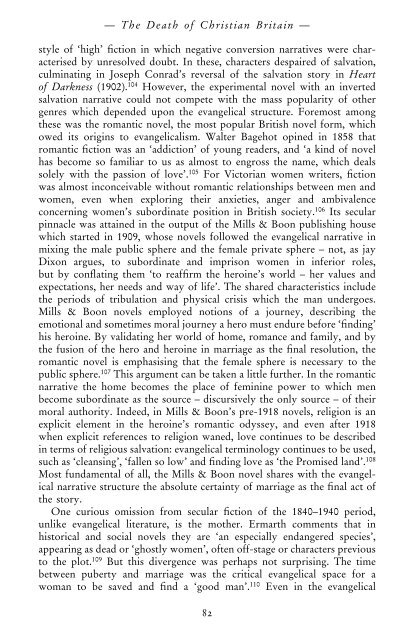The Death of Christian Britain
The Death of Christian Britain
The Death of Christian Britain
You also want an ePaper? Increase the reach of your titles
YUMPU automatically turns print PDFs into web optimized ePapers that Google loves.
— <strong>The</strong> <strong>Death</strong> <strong>of</strong> <strong>Christian</strong> <strong>Britain</strong> —<br />
style <strong>of</strong> ‘high’ fiction in which negative conversion narratives were characterised<br />
by unresolved doubt. In these, characters despaired <strong>of</strong> salvation,<br />
culminating in Joseph Conrad’s reversal <strong>of</strong> the salvation story in Heart<br />
<strong>of</strong> Darkness (1902). 104 However, the experimental novel with an inverted<br />
salvation narrative could not compete with the mass popularity <strong>of</strong> other<br />
genres which depended upon the evangelical structure. Foremost among<br />
these was the romantic novel, the most popular British novel form, which<br />
owed its origins to evangelicalism. Walter Bagehot opined in 1858 that<br />
romantic fiction was an ‘addiction’ <strong>of</strong> young readers, and ‘a kind <strong>of</strong> novel<br />
has become so familiar to us as almost to engross the name, which deals<br />
solely with the passion <strong>of</strong> love’. 105 For Victorian women writers, fiction<br />
was almost inconceivable without romantic relationships between men and<br />
women, even when exploring their anxieties, anger and ambivalence<br />
concerning women’s subordinate position in British society. 106 Its secular<br />
pinnacle was attained in the output <strong>of</strong> the Mills & Boon publishing house<br />
which started in 1909, whose novels followed the evangelical narrative in<br />
mixing the male public sphere and the female private sphere – not, as jay<br />
Dixon argues, to subordinate and imprison women in inferior roles,<br />
but by conflating them ‘to reaffirm the heroine’s world – her values and<br />
expectations, her needs and way <strong>of</strong> life’. <strong>The</strong> shared characteristics include<br />
the periods <strong>of</strong> tribulation and physical crisis which the man undergoes.<br />
Mills & Boon novels employed notions <strong>of</strong> a journey, describing the<br />
emotional and sometimes moral journey a hero must endure before ‘finding’<br />
his heroine. By validating her world <strong>of</strong> home, romance and family, and by<br />
the fusion <strong>of</strong> the hero and heroine in marriage as the final resolution, the<br />
romantic novel is emphasising that the female sphere is necessary to the<br />
public sphere. 107 This argument can be taken a little further. In the romantic<br />
narrative the home becomes the place <strong>of</strong> feminine power to which men<br />
become subordinate as the source – discursively the only source – <strong>of</strong> their<br />
moral authority. Indeed, in Mills & Boon’s pre-1918 novels, religion is an<br />
explicit element in the heroine’s romantic odyssey, and even after 1918<br />
when explicit references to religion waned, love continues to be described<br />
in terms <strong>of</strong> religious salvation: evangelical terminology continues to be used,<br />
such as ‘cleansing’, ‘fallen so low’ and finding love as ‘the Promised land’. 108<br />
Most fundamental <strong>of</strong> all, the Mills & Boon novel shares with the evangelical<br />
narrative structure the absolute certainty <strong>of</strong> marriage as the final act <strong>of</strong><br />
the story.<br />
One curious omission from secular fiction <strong>of</strong> the 1840–1940 period,<br />
unlike evangelical literature, is the mother. Ermarth comments that in<br />
historical and social novels they are ‘an especially endangered species’,<br />
appearing as dead or ‘ghostly women’, <strong>of</strong>ten <strong>of</strong>f-stage or characters previous<br />
to the plot. 109 But this divergence was perhaps not surprising. <strong>The</strong> time<br />
between puberty and marriage was the critical evangelical space for a<br />
woman to be saved and find a ‘good man’. 110 Even in the evangelical<br />
82








